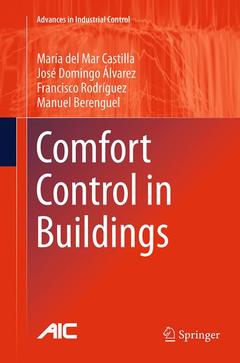Description
Comfort Control in Buildings, Softcover reprint of the original 1st ed. 2014
Advances in Industrial Control Series
Authors: Castilla María del Mar, Álvarez José Domingo, Rodríguez Francisco, Berenguel Manuel
Language: English
Subject for Comfort Control in Buildings:
Approximative price 105.49 €
In Print (Delivery period: 15 days).
Add to cartPublication date: 09-2016
Support: Print on demand
Approximative price 105.49 €
In Print (Delivery period: 15 days).
Add to cartPublication date: 07-2014
237 p. · 15.5x23.5 cm · Hardback
Description
/li>Contents
/li>Biography
/li>Comment
/li>
The aim of this book is to research comfort control inside buildings, and how this can be achieved through low energy consumption. It presents a comprehensive exploration of the design, development and implementation of several advanced control systems that maintain users' comfort (thermal and indoor air quality) whilst minimizing energy consumption. The book includes a detailed account of the latest cutting edge developments in this area, and presents several control systems based on Model Predictive Control approaches. Real-life examples are provided, and the book is supplemented by illustrations, tables, all of which facilitate understanding of the text.
Energy consumption in buildings (residential and non-residential) represents almost the half of the total world energy consumption, and they are also responsible for approximately 35% of CO2 emissions. For these reasons, the reduction of energy consumption associated with the construction and use of buildings, and the increase of energy efficiency in their climatic refurbishment are frequently studied topics in academia and industry. As the productivity of users is directly related to their comfort, a middle ground needs to be found between comfort of users and energy efficiency. In order to achieve this, it is necessary to develop innovation and technology which can provide comfortable environments with minimum energy consumption. This book is intended for researchers interested in control engineering, energy and bioclimatic buildings, and for architects and process control engineers. It is also accessible to postgraduate students embarking on a career in this area, particularly those studying architecture.
Maria del Mar Castilla is a researcher at the University of Almería, Spain. She received the Computer Science Engineering degree from the University of Almería, Spain in 2009. She obtains the Ph.D. degree in advanced comfort control techniques inside buildings, which was performed in a solar energy research centre: the CIESOL mixed centre, from the University of Almería in 2013. Her research interests are focused on the fields of identification, modelling and predictive control with applications to energy efficient buildings. She has participated in several R&D projects and is co-author of many papers in international journals and conferences. She is member of the “Automatic control, Robotics and Mechatronics” research group, and the Comité Español de Automática (main Spanish Association in Automatic Control).
José Domingo Álvarez is a postdoctoral researcher at the University of Seville, Spain. He received the Computer Science Engineering degree from the University of Almería, Spain in 2003. Then, in 2008, he obtained, from the same university, the Ph.D. degree in Automatic Control in Solar Plants which was performed in a leading research centre in this field: the Solar Platform of Almería. His research interests are focused on the fields of repetitive control, predictive control and classical PID control with applications to solar power plants and energy efficient buildings. He is a member of the “Automatic control, Robotics and Mechatronics” research group. He has been director of 2 Ph.D. Thesis, has participated in several R&D projects and is co-author of many papers in reputed international journals with high impact factor. He is also a member of the Comité Español de Automática (main Spanish Association in Automatic Control).
Francisco Rodríguez Diaz is Associate Professor of Systems Engineering and Automatic Control at the University of Almería (Spain). He obtained his Telecommunication Engineering degree from Madr
Presents a comprehensive exploration of comfort control inside buildings and how this can be achieved through low energy consumption
Discusses the main standard comfort indexes and considers the development of approximated models for such indexes
Provides real-life examples to facilitate understanding of the text
Includes supplementary material: sn.pub/extras




